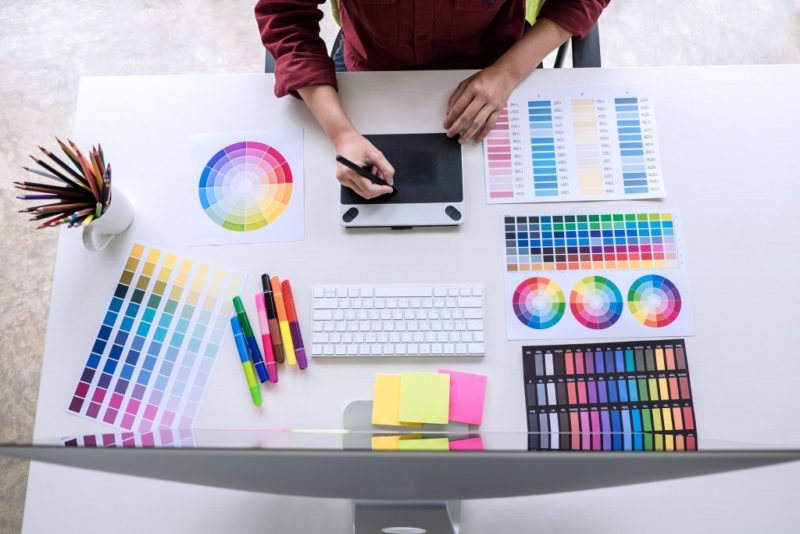Were you considering a plunge into the world of freelance design? It’s a growing field, but there’s still plenty of room to enter and make an excellent name for yourself and your skills.
As more and more people begin to join the ‘gig’ economy, it becomes critical that you stand out from the crowd. So that people not only give you jobs but good reviews and return business. Recommendations to others are always a powerful way to grow.
Whether it is finding your unique identity through private one-on-one clients or deciding on which social media platform would work for you, there is a lot to be done before you see the projects rolling in. So let’s get started!

Define Yourself
Before you launch yourself into the world of freelance design, you must define who you are, what your brand stands for, and the value that your customers will get by working with you.
To be able to compel your prospects to work with you, you need a strong brand identity. Something that grabs them and touches the trigger, getting them to choose you over others.
So, what defines your brand?
Ask yourself these questions:
- What’s your mission?
- What’s the unique personality of your brand?
- What do you specialize in?
- Who would you describe as an ideal customer?
- What describes your work?
When you have the answers to these fundamental questions, it’s time to use your superpower to design your brand!
After all, what could be better proof of your design skills than your logo, personal website, and portfolio?

Find Your Niche
To stand out in the competitive world of freelance design, you’ve got to tap into what makes you different. Is it a specific industry that you love working for and have a strong portfolio to support you?
For example, the designer, Maria De La Guardia, focuses on non-profits and business technology.
Or, is it a particular skill? Miro Hristov specializes in front-end development, and the brand identity of this designer is and beautifully conveyed through his online presence.
Sergey Shapiro is a lettering/calligraphy artist who applies his writing skills in various graphic design contexts, such as logo design and packaging design.
Be Seen

Your brand identity is apparent.
Your logo, website, and portfolio are ready.
It’s now time to get out there!
Spend a considerable amount of time, creating a strong, compelling social media presence. Find out where your prospective clients spend time online.
Instagram is usually the tool of choice for designers to showcase their portfolios. Illustrators, painters, animators, 3D designers, typographers – every design niche is seen showcased on Instagram.
For example, Margherita Urbani is a successful and prolific designer. Her Instagram page showcases an extensive catalog that is full of clever, strong, and bright design work.
However, to be visible to a professional audience, there’s great value in using LinkedIn.
While Facebook appears to be a medium to share posts within a family or friends group, there are specific groups on Facebook with visibility and influence. Spend time researching these groups.
And don’t forget Twitter. By following established freelance designers at designcontest.com and retweeting their posts, you show your audience that you are a collaborator and team player within the community.
Start a Blog

A design blog is a great tool to establish yourself as a voice in the industry and engage with your audience daily.
Express your point of view on design trends. Update your audience on your ongoing projects daily. Share links to articles by fellow bloggers.
As you build content on your blog, you begin to be noticed as an authority in the industry. There are thousands of designers offering their services on the public domain, and a well-written, engaging blog is a way to stand out from the crowd. In doing so, you also build a following and redirect traffic to your website.
A blog is also a way to appear in search results when potential clients are shopping for design services. By optimizing your blog, you will be able to appear in relevant searches and be awarded more projects!
Consider Richard Baird’s blog, for example. A household name in logo opinion, Richard Baird is the founder and editor of Brand, Packaging, and Opinion. His reviews establish him as a voice in the industry, and the links to his work give a closer look at the designs behind that voice.
Network. Network. Network

A powerful online presence will help you establish yourself in the industry and ensure that new prospects find you.
However, to ensure a steady stream of work, you must capitalize on your network.
Ensure that you stay in touch with your previous customers. They’ve seen your work and recognize your skills. Keep them engaged. Send them occasional links to your articles and ongoing design work. Always ensure that what you send is relevant to their area of business and is not perceived as spam.
As you build your customer base and the contacts of fellow designers, create customized content for each of your audience segments. Remember to respond to social media comments, emails, and other inputs you get from your contacts. People speak up on social media because they want to be heard!
Find your brand identity. Establish your niche. Stand up and speak as an authority in your space. Build and capitalize on your network. There may be a crowd out there, but with the right moves, you will find your unique space as a freelance designer!



